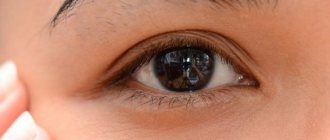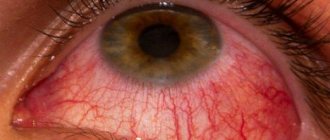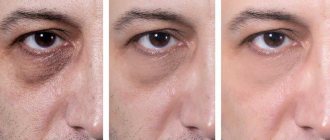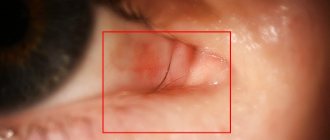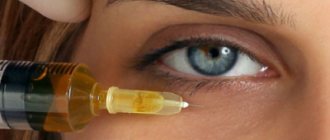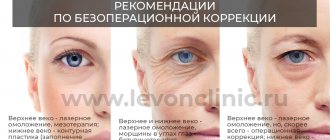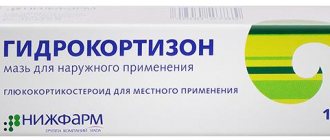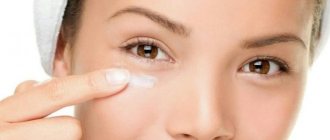Causes
The following reasons exist for the formation of pathological symptoms:
- the use of low-quality cosmetics, in some cases they may be expired, resulting in severe redness and damage to the skin;
- allergic reactions in the eyes, accompanied by excessive dryness of the corners of the eyelids (plant flowering, animal hair, dust, food products);
- insufficient intake of nutrients, vitamins, microelements and minerals from food, which forms hypovitaminosis;
- the use of certain medications to which the patient may develop hypersensitivity;
- rubbing and scratching the skin on the eyelids, which leads to mechanical damage and inflammation of the corners of the eyes;
- autoimmune reactions of the body, that is, cells of the human immune system attack their own tissues (rheumatoid arthritis, systemic lupus erythematosus);
- dermatological diseases (dermatitis, rosacea);
- inflammatory conditions of the eyelids that develop in humans over a long period of time (blepharitis, meibomitis, chalazion);
- viral eye infection;
- bacterial proliferation leading to purulent infection.
Each of these conditions is characterized not only by inflammation and cracked skin in the corners of the eyes, but also by other clinical symptoms, by which the true cause can be identified.
Causes of pain in the corner of the eye
1.Canaliculitis
. Inflammation of the tear ducts causes pain in the inner corners of the eyes. Inflammation of the tear duct develops with infectious problems both in the eye itself and in the nasal cavity. Along with pain in the corner of the eye, swelling and redness of the lower or upper eyelid, lacrimation and purulent discharge from the eyes appear. Antibacterial and anti-inflammatory drops are used for treatment.
2. Partial or complete obstruction of the lacrimal ducts
. Causes active lacrimation and discomfort in the inner corner of the eyes. The cause may be injury or tumors of the tear ducts. Often, for this reason, surgical treatment is necessary to restore the patency of the tear ducts.
3.Dacryocystitis
. Inflammation of the lacrimal sac will also cause localized pain in the inner corner of the eye. The inner corner of the eye swells and profuse purulent discharge appears. In most cases, it resolves with conservative treatment. Sometimes surgical treatment is required
4.Blepharitis.
Inflammation of the skin of the eyelids in the initial stages causes discomfort and itching in the corners of the eyes, both externally and internally.
5. Angular conjunctivitis
. Infectious inflammation of the mucous membrane caused by the Morax-Axenfeld bacterium affects the skin of the eyelids in the corner of the eyes. In this case, a characteristic clinical picture develops: the corners of the eyes hurt, turn red, and small cracks appear. Pain in the corners of the eyes worsens when blinking.
6.Ocular herpes
. A herpetic eye infection may begin with discomfort in the outer corner of the eye. As symptoms increase, swelling of the eyelid, pain in the eyes, redness and photophobia appear.
7.Ingrown hair (eyelashes)
Ingrown hairs in the inner corner of the eye can cause discomfort and redness in the inner corner of the eye. However, it is impossible to see the problem with the naked eye.
8.Allergic conjunctivitis.
If you experience nasal congestion and watery eyes along with unpleasant sensations in the corners of your eyes, an allergy may be the cause. Treatment is carried out with antihistamines.
9. Wrong glasses
. In some cases, improper adjustment of the nose pads in the frames of glasses causes pain or discomfort in the corners of the eyes.
10. Computer vision syndrome.
Many people experience gas discomfort and discomfort in the corners of their eyes when looking at computer screens, tablets and phones. The severity of symptoms directly depends on the amount of time spent looking at the screen. Go away on their own after rest or sleep.
Treatment
For each individual pathology that appears, there is a specific treatment. Most often doctors prescribe the following medications:
- antibacterial drops (Tobrex, Vigamox);
- antibacterial ointments (Erythromycin, Tetracycline, Levomekol);
- antiviral drops (Poludan);
- antiviral ointments (Floreal, Bonafton);
- systemic antiviral drugs (Acyclovir, Arbidol);
- non-steroidal anti-inflammatory drops and ointments based on diclofenac;
- non-steroidal anti-inflammatory drops and ointments based on hormonal substances, for example, dexamethasone;
- wound healing ointments (Solcoseryl);
- multivitamin drops in the eyes to improve metabolism and general tissue condition;
- multivitamin preparations for oral administration (Aevit, Alphabet, Blueberry Forte).
Antibiotics and steroids must be used for a short course of treatment to avoid side effects. All other drugs can be used with prolonged action, the body will not become addicted.
How to provide first aid?
If it is not possible to see a doctor, you need to rinse your eye with clean water.
If a person notices red whites or the corners of the eyes that are cracking, first of all it will be necessary to eliminate the probable causes that contributed to this condition. When there is a suspicion that foreign bodies have penetrated the visual organs, you should try to remove them using sterile means at hand. Doctors then recommend rinsing your eyes with warm running water. If the redness of the corners of the eyes is caused by any disease, treatment of this pathology is started first.
To quickly get rid of redness, you should resort to compresses. For these purposes, gauze or a cotton swab is dipped in cool water and then applied to the affected visual organs for 10 minutes. Instead of water, you can use a decoction of medicinal chamomile or tea. However, before these manipulations, it is important to make sure that there is no allergy to these products. Redness in the outer corner of the eye will help relieve drops that have vasoconstrictor or moisturizing properties. If the redness does not go away within several days, you should contact a medical institution, where the appropriate diagnosis will be carried out.
Prevention
To prevent dry eyelid skin, redness and inflammation, it is recommended to use the following preventive measures:
- periodic visits to doctors of narrow specialties for a general examination and laboratory tests;
- proper eyelid skin care, use of moisturizing ointments;
- no use of expired cosmetics; it is necessary to monitor the quality of each product used;
- maintaining good hygiene, especially with regard to the use of contact lenses;
- eating food containing all the vitamins and nutrients; if this is not enough, use multivitamin courses for prevention;
- timely treatment of all systemic diseases.
With strict adherence to all methods of prevention, it is not always possible to prevent ophthalmological disease. But the risk of their occurrence will be significantly reduced.
How is the treatment carried out?
The anti-inflammatory effect lasts up to eight hours after instillation.
Therapy for redness of the corners of the eyes is based on relieving the factor that caused this unpleasant symptom. If the pathological condition is caused by bacteria, broad-spectrum antibiotics are used. Medicines from the group of sulfonamides or ampicillins can be used. If spots appear near a person’s eyes, it is recommended to burn them with brilliant green. The following drops will help cope with redness, swelling and itching of the eye:
- "Dexamethasone";
- "Prednisolone";
- "Visine."
Medicines for topical use in the form of creams and gels can be used. Mostly they resort to tetracycline ointment. If the redness of the eyes is accompanied by the discharge of pus, and drug therapy does not bring the required effect, the patient is prescribed surgical correction, with the help of which the causes of the inflammatory process can be eliminated.
Barley
Barley appears on the eyelid due to the onset of an inflammatory process. The cause of this is most often a bacterial infection, in particular Staphylococcus aureus. The following factors can provoke activation of the inflammatory process:
- hypothermia;
- weakened immune system;
- chronic diseases;
- bad ecology;
- overwork;
- monotonous food;
- taking medications.
The child develops swelling, itching, and burning in the eye area. This also affects the general condition, the baby becomes capricious and refuses to eat. Severe redness of the eyelid also extends to the conjunctiva.
The swelling is local at first and then spreads throughout the eye. Around the fifth day, the barley opens. Sometimes the abscess resolves on its own, but this is the exception rather than the rule.
Internal stye must be monitored especially carefully, as it can rupture into the conjunctiva and cause a general infection of the orbit.
Treatment of eye inflammation includes the use of eye drops:
- Oftalmoferon. It is even approved for use by newborn children;
- Albucid helps cure barley in the shortest possible time. The drops are very hot, so the baby will resist such treatment in every possible way;
- Tobrex does not sting the child’s eyes, but at the same time has pronounced antibacterial properties.
Eye ointments are also used, which are placed under the lower eyelid. This dosage form does not cause irritation to the mucous membrane. Doctors usually prescribe erythromycin and tetracycline ointments.
Populists advise using herbs that have anti-inflammatory activity: plantain, chamomile, string, calendula. As dry heat, you can use a warm egg or a bag of salt heated in a frying pan.
Aloe juice also helps stop the inflammatory reaction. It must be diluted in equal proportions with water. Soak a small piece of cotton wool in the resulting solution and apply to the affected area.
Stye is a common cause of eye inflammation in children.
Influence of the external environment
People with inherently dry skin are susceptible to environmental factors. For example, in winter, in the wind, the delicate skin around the eyes very quickly begins to peel off. This happens due to the fact that the thickness of the skin in this area is very small. In this case, a moisturizing and nourishing cream will help cope with the cosmetic defect, which is used not only at night, but also under makeup before going outside. In this case, all layers of the skin will receive a sufficient amount of nutrients. The cream film also creates an additional protective barrier that will help prevent the negative impact of aggressive weather conditions on the delicate skin around the eyes.
